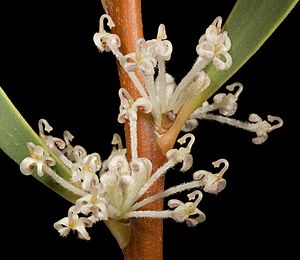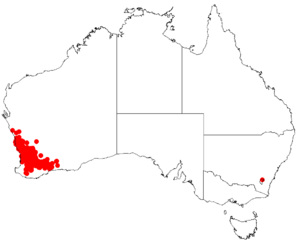Marble hakea facts for kids
Quick facts for kids Marble hakea |
|
|---|---|
 |
|
| Scientific classification | |
| Genus: |
Hakea
|
| Species: |
incrassata
|
 |
|
| Occurrence data from AVH | |
The Marble Hakea (Hakea incrassata) is a cool shrub. It belongs to the Proteaceae family, which has many unique Australian plants. This plant only grows naturally in Western Australia.
Contents
About the Marble Hakea
What it Looks Like
The Marble Hakea is a spreading shrub. It can also grow as a low, compact bush. It usually reaches a height of about 0.35 to 1.5 meters (1 to 5 feet). This plant has a special woody swelling at its base called a lignotuber. This helps it regrow after a fire.
Its branches have fine, white, flattened hairs. The leaves are flat, stiff, and stay green all year. They are twisted at their base and have a narrow, oval shape. These leaves are about 1.1 to 8.5 centimeters (0.4 to 3.3 inches) long. They are also 3 to 11 millimeters (0.1 to 0.4 inches) wide.
Flowers and Fruit
The Marble Hakea blooms from June to November. It produces pretty white, cream, or pink flowers. These flowers grow in clusters (called an inflorescence) from the older parts of the branches. Each cluster usually has 6 to 16 flowers.
The flower parts (called the perianth) are about 2 millimeters (0.08 inches) long. They are covered with stiff white or pale brown hairs. After the flowers, round, smooth fruits form. These fruits can also have black, pimply spots. They are about 1.7 to 3.3 centimeters (0.7 to 1.3 inches) long and wide. Inside, the seeds have a wing around them. This wing is about 12 to 20 millimeters (0.5 to 0.8 inches) long.
Naming the Marble Hakea
Scientific Name
The Marble Hakea was first officially described in 1830. A botanist named Robert Brown gave it the scientific name Hakea incrassata. He wrote about it in his work called Supplementum primum prodromi florae Novae Hollandiae.
There is only one other known scientific name for this plant. It was once called Hakea leucadendron by Carl Meissner.
Meaning of the Name
The second part of its scientific name, incrassata, comes from a Latin word. Crassatus means "thickened." Scientists are not completely sure what part of the plant this refers to. However, some think it might describe the thick stalk that holds the fruit.
Where the Marble Hakea Grows
Natural Home
The Marble Hakea grows naturally in a large area of Western Australia. You can find it across the Wheatbelt, Great Southern, and Goldfields-Esperance regions. Its range stretches from Northampton in the northwest to Ravensthorpe in the southeast.
Preferred Environment
This plant likes to grow in open, low heath areas. It is often found in sandy or gravelly soils. These soils are usually found on top of or around laterite or granite rock formations.


